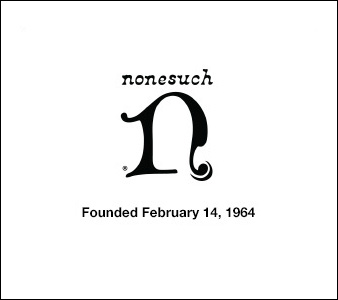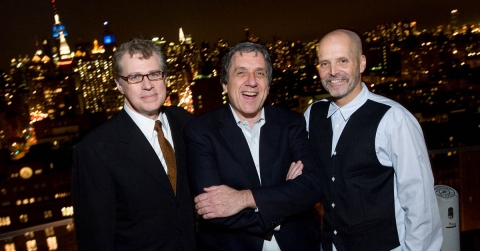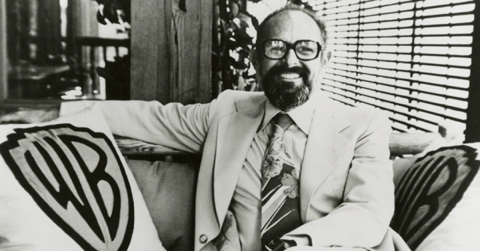Today is the 50th anniversary of Nonesuch Records. It was 20 years after the founding, 30 years ago today, that Bob Hurwitz, the label's president, was offered that position. Here he reflects on his early days at the company.
By Robert Hurwitz
Today is the 50th anniversary of Nonesuch Records. As significant as this date is for our company, far more significant for me personally was the 20th anniversary of Nonesuch: Valentine’s Day 1984. I was running the American operations for ECM Records at the time, and around three in the afternoon, I got a call from Ruth Rosenberg, the assistant to Elektra’s chairman Bob Krasnow who said (as she would say hundreds of times in the ten years we worked together), “Bob wants to see you, right now.” This very instant.
Bob had modernist furniture in his office, and the couch I sat on was as low as a couch could be; sitting across from him and Bruce Lundvall, the president of Elektra (who months later would become the head of Blue Note Records), I was asked if I wanted to run Nonesuch, which was then part of Elektra. I still see Bob and Bruce peering down at me sitting on this ridiculously low couch. I said, "Of course, the obvious answer is, that's a wonderful offer, thank you very much, let me think about it …” A pause. “But really, there's no way I'm going to say no.”
I was a fan of the label, especially during the days of Tracey Sterne, who ran the company for 14 years and was famously fired by then-Chairman Joe Smith. Tracey was brilliant, highly imaginative, volatile, utterly dedicated to her job and it was because of her tremendous accomplishments that Nonesuch was still an important company when I was offered this job. When she was fired, every artist on the Nonesuch roster said they would leave the label. Steve Ross, the chairman of Warner Communications, Elektra’s parent company, received thousands of letters from angry fans of the label (imagine what this reaction would have been in the age of the Internet). The departing musicians of Nonesuch all signed a letter printed in the New York Times asking her to be re-instated.
# #
Together Tracey and I have led Nonesuch for 44 years of the company’s 50-year-history. Nonesuch was founded by the great record business visionary Jac Holzman, the founder of Elektra, who, as the legend goes, decided that just as college students in 1964 were buying these relatively new objects called “paperback books”—far more affordable than hardcovers—perhaps a record company might sell its equivalent: budget recordings of great repertoire and with great sound that could be sold for two or three dollars. He went to Europe, bought the masters of about 35 records for a thousand dollars each, most of them with exceptional performances of known and unknown classical music, and Nonesuch was born.
Jac is one of the great legends of the record business. There have been few independent companies that have made a mark as profound as Elektra, and when he sold the company to Warners in 1970, it included the six-year-old Nonesuch Records. He always had a great ear and eye for talent, and although he never signed anyone that had the worldwide impact of The Doors or Queen or Love to Nonesuch, his decision to hire Tracey Sterne may have been far more important than any single musician or composer he might have brought to the label. Tracey, who was a child prodigy on the piano and played with the New York Philharmonic at the age of 15, eventually found her way to Vanguard Records and started running Nonesuch in 1965, a year after it started, and made her mark almost immediately.
# #
I started hearing about Nonesuch in the early ’70s, and was especially taken by the imaginative recordings of new and unusual music. I even reviewed a few for the now-defunct magazine Changes. I heard masterpieces like George Crumb’s Ancient Voices of Children, the Carter String Quartets (and the Double Concerto, and the masterful Quartet for Flute, Oboe, Cello and Harpsichord) for the first time on Nonesuch records; not to mention Paul Jacobs’s stunning Debussy Preludes, Charles Wourinen’s Percussion Symphony, Babbitt’s All Set—recordings that made a tremendous impression and could only be heard on Nonesuch. And Tracey also was deeply involved in creating the most important world music series this country has ever known, the Explorer Series, which made music from all around the world accessible, and at a budget price. Imagine!
Thankfully, I was not offered the job on Valentine’s Day 1979, the year she left. How could anyone follow Tracey? No one wants to follow an act like that.
That nearly impossible job fell to Jac Holzman’s younger brother Keith, who had a monumental task trying to pick up the pieces. At first, all of the great artists who worked with Tracey—like Jan DeGaetani, Gil Kalish, Paul Jacobs, and Bill Bolcom—were still boycotting, but one by one, they all came back. Before they returned, Keith, not to be deterred, found a new community of musicians from California and New York, and somehow kept the label going for the next five years.
# #
Even before I took the job at Nonesuch, Bob Krasnow already loomed large in my life, from the time he successfully convinced my boss at ECM, Manfred Eicher, to take the company over to Warner Bros. in 1978. He was one of the two or three key executives working for Mo Ostin, the chairman of Warners, and as successful in A&R as anyone in the music business.
No one ever challenged me professionally in the way he did. And nothing would have been possible without his astonishing support and belief in my ideas. That said, when I got to Nonesuch, I was filled with anxiety—attributable to the incredible reputation of both the label and Tracey Sterne; to knowing I was working for someone as demanding and brilliant as Krasnow; to having worked for nine years with the also brilliant Manfred Eicher at ECM, whose many innovations and accomplishments created a standard I felt I had to live up to; to the fact that my taste in new music (Adams, Glass, Reich) was on the opposite side of Nonesuch’s historical commitment to new music (Carter, Babbitt, Wuorinen) and that the music critic community had been so supportive of the latter and often detested the former; to the realization, at the age of 34, that this was probably going to be the one and only great opportunity I would have to run a label and hopefully make a difference. During these days, Stephen Sondheim and James Lapine were finishing Into the Woods, and the line from the show that always resonated most with me—“Opportunity is not a lengthy visitor”—best described the state I was in.
Racked with anxiety, I went to Bob with my concerns of the artist roster I had inherited. “Drop them all.” It was like a punch to the gut. There were some good musicians there, I didn’t know most of the new signings from Keith, and how could anyone face telling 40 exceptional musicians that their deals were over?
What I did not realize was that—whether based on intuition or based on knowledge—Bob understood that what makes a small label work (he came from that background, starting the legendary Blue Thumb Records) was a kind of kinship between artist and label that was more than a name; there had to be a real connection. And he was right—I did not have a genuine connection to most of the musicians I had inherited, as good as they all were. (There were two exceptions: the pianist Richard Goode, with whom we still work, and the great soprano Teresa Stratas, with whom we made her last recording.)
One other thing Bob said to me, at another moment when I confronted him with my own uncertainty. “Why are you bothering me with this? I hired you to run Nonesuch; it’s your problem, not mine. Talk to me in five years, and then we’ll see if you still have a problem.”
# #
When I got the job, I was told that I could start with two employees. (Two coincidences: during Tracey’s day, one of her two staff members was a girlfriend of mine for a time after she left the company; one of the two employees in Keith’s day was one of my wife’s best friends … I knew quite a bit about the inner workings of Nonesuch long before I got there.) About 40 people, all industry vets, called on me in the first month expressing interest in a job. The first was a man who worked at Philips named Peter Clancy; the second was David Bither, who worked at our parent company, Warner Communications. Peter and David were keenly interested in coming to work with me at Nonesuch. I had several concerns—did they love new music (yes, they both did), were they smart (they both were), were they likable (they both were), and perhaps most importantly, would Krasnow like them (I thought so).
Peter had ten years of experience in the music business. David, like Peter, was a musician; he had written a lot about music, had worked in the non-profit world, and was then in a corporate position at the parent company. Even David agreed that Peter, with all of his record company experience, would probably be a better choice in the beginning, and anyway, David was able to persuade his bosses at Warners that he could take care of business and still find time to volunteer at Nonesuch a few floors away, so initially, he was giving us time every week. He eventually made an impression on Krasnow, who invited him to come to work at Elektra a few years later—which he did with great distinction until, during a mid-’90s corporate changeover, he was able to finally come work with us at Nonesuch full-time.
# #
The things that caused me great anxiety in 1984 (those mentioned above) have all gone away, but were replaced by others. Krasnow’s firing in 1994 made me think it was all going to be over—he was so supportive and so encouraging, I did not think Nonesuch would survive without him. But we survived. During these 30 years, the parent company got sold four times. The record division had changes of management a half dozen times. Napster entered our life. Record stores disappeared. File sharing. Pirate sites. MySpace. YouTube. Artists doing without labels.
 |
| Bob Hurwitz with John Adams & Steve Reich. Tanglewood, 1985. Photo by Peter Clancy. |
The first two people signed to Nonesuch were the composers Steve Reich and John Adams. I had worked with both at ECM. I had no interest in going after any artists who had recorded for my former company. But that didn’t mean if they made a call to me I would not listen. And when Manfred Eicher abruptly cancelled the recording of Steve Reich’s Desert Music the first week I was on my job, of course I was happy to have him be the first artist signed on my watch at Nonesuch. We have been able to record every note that Steve has written in these past three decades; we have happily watched the world catch up with his music and see him as one of the most beloved and influential composers in the world today.
I had brought John Adams to Manfred’s attention in the early ’80s, and he agreed to record John’s masterpiece Harmonium, then decided against it. The recording was scheduled for January 1983, a year before I was hired at Nonesuch and when I got the news that ECM was pulling out, I went to Bob Krasnow’s office, sat on his low couch, and asked if perhaps Nonesuch would make the record. Krasnow said yes, but when I gave this news to Manfred, he decided to have ECM make the recording after all.
When I got to Nonesuch, Keith Holzman, who did not have Tracey’s keen interest in modern music but felt it was important to continue that tradition, had made a deal with Meet the Composer to record the new works—sight unseen, and without being part of the selections process—of composers in residence at American orchestras. Nonesuch did not have any say in the selection of the composers, but miraculously, one of them was John Adams, the composer in residence at the San Francisco Symphony.
Each composer was supposed to write a 20-minute piece, and it would be released on a disc with another composer’s work. John said—and I was never sure if he was joking or not—that he wrote the second and third movements of Harmonielehre because it would mean he could have the entire disc. It was our first album for Nonesuch. The record was made early in 1984, and the day after, I had breakfast with John, his wife Debbie, and their then-one-year-old daughter Emily in San Francisco and told him that nothing could make me happier than having Nonesuch become his home, and whenever possible, we would make the first recordings of all of his new compositions. He said yes. It was true—nothing could make me happier than recording John Adams’s music.
# #
Today, on the 50th anniversary of Nonesuch, down the hall from me is David Bither, who has become a tremendous force in the company, signing artists like Wilco, Youssou N’Dour, Emmylou Harris, and Carolina Chocolate Drops; right now he is working hard setting up the next record by The Black Keys, his most successful signing, a band on the verge of breaking through on what, for us, is an unprecedented level. On the other side, Peter Clancy, still the head of marketing, is trying to figure out how to market classical records like Jeremy Denk’s, Brazilian records like Caetano Veloso’s, and we-don’t-even-know-what-to-call-it records like Punch Brothers, not to mention blockbusters like The Black Keys and new breaking artists like Rhiannon Giddens.
Steve Reich and I are talking about the final details of his next recording, Radio Rewrite; we’ve finally set a date to record in early April at Avatar Studios, and we’re coupling it with Jonny Greenwood playing Steve’s wonderful composition for guitar, Electric Counterpoint. John Adams and I are putting the final touches on the cover for his new album of City Noir and the Saxophone Concerto, two sensational pieces he’s just had recorded with David Robertson and the St. Louis Symphony.
February 14, 1964, 1984, 2014, another day at Nonesuch.
- Log in to post comments



